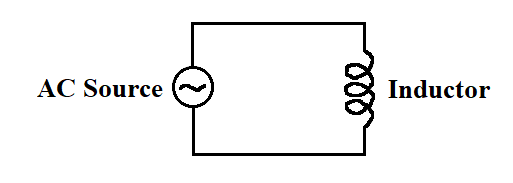
Inductive reactance of a coil is expressed in
A. Ampere
B. Ohm
C. Volt
D. Weber
Answer
575.7k+ views
Hint: Inductive reactance is the opposition offered by an inductor in an alternating current circuit to the flow of alternating current. Unlike resistance, Inductive reactance can vary with the frequency of the input voltage. In an inductive circuit, the current lags the voltage by a phase difference of ninety degrees.
Complete step by step answer:
Reactance is described as the opposition offered by a capacitor or an inductor, or both, in a circuit to the flow of the Alternating current in the circuit. The reactance is quite similar to resistance but reactance varies with the frequency of the alternating voltage source.
An inductor is simply a coil of wire. When current passes through the inductor coil, an electrical field is generated; the field has actually been induced. The bigger the coil or the greater the number of turns in the coil, the greater will be the induced electric field. This phenomenon of the generation of the induced electric field is known as inductance.

Inductive reactance is the name given to the opposition by an inductor to a changing current flow in the circuit. This impedance value is measured in ohms, just like the resistance. The inductive reactance is represented by ${{X}_{L}}$ and measured in ohms $\left( \Omega \right)$.
The formula for calculating the inductive reactance of a coil is given by:
${{X}_{L}}=2\pi fL$
Where,
${{X}_{L}}$ is the inductive reactance in ohms
$f$ is the frequency of the alternating current in hertz
$L$ is the inductance of the coil in henry
The inductive reactance of a coil is expressed in Ohms.
So, the correct answer is “Option B”.
Note: According to the formula of Inductive reactance, the value of inductive reactance is proportional to the frequency of the input voltage and the inductance of the coil. Inductive reactance is mostly low for lower frequency and high for higher frequency input voltages. The value of inductive reactance is negligible for the direct current input voltage.
Complete step by step answer:
Reactance is described as the opposition offered by a capacitor or an inductor, or both, in a circuit to the flow of the Alternating current in the circuit. The reactance is quite similar to resistance but reactance varies with the frequency of the alternating voltage source.
An inductor is simply a coil of wire. When current passes through the inductor coil, an electrical field is generated; the field has actually been induced. The bigger the coil or the greater the number of turns in the coil, the greater will be the induced electric field. This phenomenon of the generation of the induced electric field is known as inductance.

Inductive reactance is the name given to the opposition by an inductor to a changing current flow in the circuit. This impedance value is measured in ohms, just like the resistance. The inductive reactance is represented by ${{X}_{L}}$ and measured in ohms $\left( \Omega \right)$.
The formula for calculating the inductive reactance of a coil is given by:
${{X}_{L}}=2\pi fL$
Where,
${{X}_{L}}$ is the inductive reactance in ohms
$f$ is the frequency of the alternating current in hertz
$L$ is the inductance of the coil in henry
The inductive reactance of a coil is expressed in Ohms.
So, the correct answer is “Option B”.
Note: According to the formula of Inductive reactance, the value of inductive reactance is proportional to the frequency of the input voltage and the inductance of the coil. Inductive reactance is mostly low for lower frequency and high for higher frequency input voltages. The value of inductive reactance is negligible for the direct current input voltage.
Recently Updated Pages
Master Class 12 Economics: Engaging Questions & Answers for Success

Master Class 12 Maths: Engaging Questions & Answers for Success

Master Class 12 Biology: Engaging Questions & Answers for Success

Master Class 12 Physics: Engaging Questions & Answers for Success

Basicity of sulphurous acid and sulphuric acid are

Master Class 12 Business Studies: Engaging Questions & Answers for Success

Trending doubts
What are the major means of transport Explain each class 12 social science CBSE

Which are the Top 10 Largest Countries of the World?

Draw a labelled sketch of the human eye class 12 physics CBSE

How much time does it take to bleed after eating p class 12 biology CBSE

Explain sex determination in humans with line diag class 12 biology CBSE

Differentiate between homogeneous and heterogeneous class 12 chemistry CBSE




